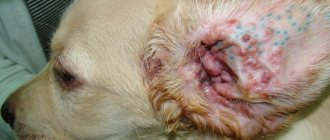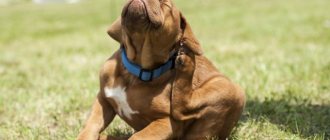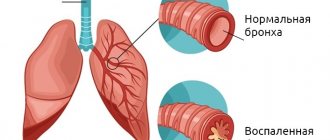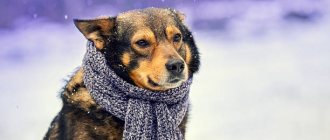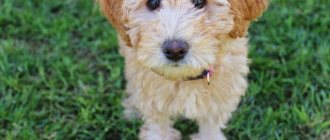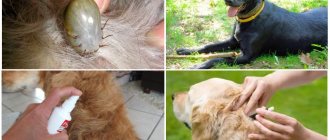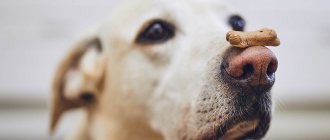Canine arthrosis: general information
In dogs, arthrosis appears gradually, starting with damage to cartilage cells; after a while, the disease “spreads” and affects the entire joint, bone tissue and ligaments. As a rule, gradual primary arthrosis is diagnosed in older dogs, when the joint simply wears out and cannot withstand the constant stress and loads that arise throughout the animal’s life. Secondary arthrosis affects dogs that have been injured or overworked. Arthrosis is not uncommon in large and giant dog breeds: Great Danes, Bernese Mountain Dogs, Rottweilers and the like.
Wear of cartilage due to arthrosis in dogs
Weight management
No matter what your dog's joint health looks like, it's important to maintain a healthy weight and an active lifestyle. In dogs with osteoarthritis, bearing excess weight on damaged joints is not only painful, but can also speed up the process of cartilage breakdown.
In healthy dogs, obesity can predispose them to earlier development of osteoarthritis, as well as many other diseases.
If your dog is overweight or obese, your veterinarian is your best resource to help you start a diet and exercise plan to improve your dog's health.
X-ray for animals in Moscow https://goodhands.vet/services/rentgen/
Distinctive features of the disease
It is necessary to distinguish arthrosis in dogs from arthritis. The main difference is the inflammatory nature of arthritis. Arthrosis often occurs against the background of arthritic inflammatory processes. With arthritis, an increase in the animal's temperature and swelling of the diseased joint are observed. Osteoarthritis occurs in older dogs, usually from the age of 8 years, many animals are diagnosed with certain signs of osteoarthritis of the joints.
It has been noted that large breeds of dogs, such as Great Danes, Mastiffs, Labradors, Alabais, and Shepherds, are more likely to suffer from this chronic joint disease. There was no significant difference in incidence among dogs by gender.
Diagnostic methods
The most informative method for diagnosing the disease is x-ray. The image will clearly show bone growth, reduction or disappearance of the joint space, and coarsening (compaction) of the bone plates near the organ cavity. It is imperative to take a blood test for biochemistry: this way you can get a clinical picture of the problems of mineral metabolism. It is worth remembering that the process cannot be reversed, so treatment of arthrosis in dogs of medium and large breeds will only be aimed at stopping the disease. It is important for your pet to create conditions for normal movement and life.
How does it manifest itself in pets?
Pathology is expressed differently depending on the following factors:
- Age category.
- Concomitant diseases.
- Number of damaged joints.
- Stage of arthrosis.
Owners usually begin to notice that the dog is limping. But the signs may vary. For example, when the joints of the hind limbs are affected, the function of the pelvic girdle is impaired. The dog moves unsteadily and his gait becomes unsteady. It is difficult for him to get up, fatigue overcomes quickly.
The degree of lameness is influenced not only by how affected the joints are, but also by the structure of the pet and the characteristics of the nervous system. There are dogs that have a high pain threshold, and lameness is noticed in the later stages of the disease. The veterinarian and owner should remember this when treating. Then the absence of lameness will not be a reason to stop therapeutic measures.
The severity of symptoms varies throughout the day. For example, the main symptom of the disease is initial lameness, which can be seen after sleep. Usually during the morning awakening, because the dog had been at rest for a long time. It is difficult for the pet to get up, the lameness will be severe until the functional ability of the joint is normalized. Afterwards the symptom will become weaker or disappear.
How dangerous is the condition?
The unnoticed development of arthrosis is very dangerous for a pet. Developing gradually, arthrosis is able to “capture” an increasing amount of tissue.
The initial stage of the pathology is characterized by a violation of the integrity of the cartilage tissue of the joint. Gradually, more and more destruction occurs, and with complete thinning, mechanical friction of the bones is noted during the operation of the joint. Most often, this problem occurs in representatives of large breeds.
Lack of exposure in the early stages is dangerous due to the following conditions:
- the occurrence of painful sensations when the animal moves;
- the dog’s gait and its stability change;
- In places of unprotected contact of bone tissue, cracks, grooves and depressions appear. This disrupts the natural structure of the joint capsule and its destruction;
- lameness begins;
- In the later stages of the disease, the dog may lose the ability to move.
The disease can occur gradually, moving from one stage of development to another. However, there is also the manifestation of arthrosis in dogs due to injury, large body weight, and also heredity.
Why does it appear
There may be several reasons for the development of arthrosis, although it is worth considering the type of origin of the disease: primary or secondary. Each of these cases has its own, most characteristic root causes, but the common factors in the development of the disease usually include:
- age of the dog (the older the pet, the greater the likelihood of a problem);
- increased physical activity on the animal, characterized by a stable effect;
- obesity and excess weight (relevant for representatives of large and small breeds);
- untreated arthritis;
- joint tissue injuries;
- joint dysplasia, a genetic disorder that causes abnormal formation of the hip joint.
The more of the listed factors simultaneously affect a particular dog, the greater the likelihood that it will develop arthrosis. However, it should be noted that in animals with an average body weight, the disease is less common than in the rest of their relatives, especially if they are no more than two years old. Different types of arthrosis also have their own underlying causes.
We also recommend reading about the types and symptoms of arthritis in dogs and how to treat it at home.
Primary
Primary arthrosis develops mainly in older animals and only gets worse as the pet ages. From a physiological point of view, the basis for its manifestation is a decrease in the level of calcium in bone tissue, poor circulation and changes in the structure of cartilage. At the initial stages of development of the problem, it can be eliminated by normalizing the level of calcium in the body and restoring blood circulation, for which appropriate medications are used.
Secondary
The secondary type may appear as a result of untreated chronic arthritis, increased accumulation of calcium salts in the bones, or various injuries. Unlike the previous option, age does not play a special role here, so even puppies can suffer from secondary arthrosis.
Which dogs are predisposed to the disease?
In addition to age, there are several other characteristics that predispose dogs to arthrosis. Thus, representatives of large and giant breeds (for example, Great Danes, Mastiffs, Shepherds) more often suffer from increased mechanical stress on the joints of the limbs, and dogs of the so-called “fighting breeds” (American Staffordshire Terriers, Pit Bull Terriers) often receive injuries that predispose them to the appearance of arthrosis .
In dogs of dwarf breeds, the disease may be the result of systematic jumping of the kneecap out of place, which is facilitated by jumping from heights and fast running of animals. We also cannot exclude the possibility of the disease manifesting itself as a complication of arthritis.
Did you know? The most prolific dog was a female Neopolitan mastiff named Tia from the UK. She gave birth to 24 puppies at one time, of which 20 babies survived.
Pathogenesis
The stages of development of arthrosis listed below are distinguished:
- The initial phase is diagnosed accidentally during an examination. Inconspicuous growths are found on the articular edge. In the epiphyses of tubular bones, single spots are noted, indicating the initial stage of osteoporosis.
- The second stage is characterized by weak muscle tone. The dog tries not to stand for a long time and steps over. Lameness is detected, which intensifies with prolonged movement. Joints crunch. An x-ray allows you to notice a narrowing of the interosseous space.
- The third phase of arthritis development is characterized by severe deformation of the joints followed by their fusion. The dog reacts painfully to palpation of the affected joint. Blood tests show acidosis and a drop in the level of calcium, carotene, and phosphorus.
Injuries
There are the following types of injuries:
- wounds;
- sprains;
- dislocations.
Wounds
Incised wounds are covered with scab and heal well if the conditionally pathogenic microflora does not penetrate into the joint. The animal needs rest. If the defect is extensive, stitches are applied. Protect the wound from secondary infection. When suppuration develops, antibiotic therapy is used locally, in the form of powders.
Puncture wounds are more difficult to treat. Their consequence is purulent arthritis if the pathogenic microflora enters anaerobic conditions.
Preventive measures
It is not possible to completely rid an animal of hip dysplasia. All dog owners should understand this. But with timely and regular treatment, the development of the disease can be stopped. It is by using special nutritional supplements, regular walks, painkillers and anti-inflammatory drugs. The same chondroprotectors, physiotherapy techniques, massage, magnets, you can ensure that in old age your dog will be able to move and live normally.
But pet owners need to clearly understand that all medical measures to treat such ailments will not help with obesity in a pet. Therefore, in case of articular pathology, it is very important to first of all put the animal’s weight in order. Of course, in this case, you shouldn’t give him just water. But it doesn’t hurt to find an experienced veterinarian who can help you balance your pet’s diet aimed at reducing its weight.
You should always remember the importance of regular walks during such an illness. Under no circumstances should your dog lie down all the time when his joints hurt. Walking at a healthy pace is very important for maintaining muscle and tendon tone. If this is not done, the disease will develop even more, which will negatively affect the general condition of your dog. It is very important to exercise your pet every day, and not just during Sunday walks.
Treatment of osteoarthritis
Unfortunately, osteoarthritis is a progressive disease for which there is no cure.
Preventing the development of osteoarthritis through diet, exercise, and the use of joint-protective supplements is the best way to keep your dog's joints healthy.
When osteoarthritis develops, treatment is usually aimed at controlling pain, reducing inflammation, improving quality of life, and slowing the progression of the disease. Treatment for osteoarthritis is usually multimodal, meaning that several different treatments are used simultaneously to achieve the best results.
Arthrosis in dogs: what is it, what are the symptoms and treatment?
Under the influence of the disease, the cartilage of the joints is gradually destroyed, which means that exposed areas of bone begin to appear and come out. The cartilage of the joints begins to deteriorate due to dysfunction of the tissues, the main one of which is to prevent contact with each other and ensure free movement during movement. Because of this, open areas of the bone begin to appear, they collide with each other more often and become deformed. Cracks and dents form. Because of this, the shape of the socket at the joint changes, which means that various tissues and ligaments can grow together incorrectly, this causes complications and pain, otherwise it is called deforming arthritis.
With arthrosis, the dog’s metabolism and various metabolisms in the body begin to be disrupted, and incurable joint diseases and deformation appear.
Arthrosis in dogs can be caused by two main reasons and factors: advanced arthritis or hip dysplasia. The pathology disrupts the growth and development of joints. They begin to grow together incorrectly, causing the pet to feel discomfort.
Both sexes of dogs are susceptible to arthrosis due to dysplasia; the size of the dog also does not affect it. If we single out the breeds that get sick most often, then these are: Labrador, mastiff, collie, German shepherds, Shiba Inu, as well as pugs, Chihuahuas and some other species.
Arthrosis in dogs: types of disease
In total, the disease and its stages can be divided into two main types: primary and secondary.
Primary arthrosis is inextricably linked with the dog’s age. It is logical that the older the dog is, the higher the likelihood of developing arthrosis. This happens due to disruption of blood flow in the body, immunity deteriorates, bones become thinner and wear out faster, as well as a lack of calcium and poor tissue regeneration. Trauma or a blow can accelerate the disease and worsen the condition, but age is most often the culprit.
Secondary arthrosis develops after the body is exhausted from arthritis, which was neglected and not treated in any way. Again, this includes a decrease in calcium in the bones, erosion, weak cartilage, etc. The disease can develop in any joint of the dog; just at one moment a growth forms on the cartilage, which destroys the cartilage of the bone and disrupts the usual normal functioning. When moving, the animal feels pain and discomfort, but externally no bruises or inflammation are observed.
There are four types of disease:
- Osteoarthritis of the knees - it is obvious that with arthrosis of the knees the animal limps, can jump on three legs, does not want to run and jump, and apathy for walks in the fresh air often appears.
- Arthrosis of the shoulder - the pace of steps shortens and decreases, sometimes the animal can continue to shuffle while standing still. The dog has difficulty getting up and climbing steep slopes and stairs.
- Osteoarthritis of the hind legs - it is difficult for the animal to climb steep slopes; it rises more slowly after lying down, especially after sleep. The paws may sag under the dog.
- Osteoarthritis of the pelvis – often the dog has difficulty walking after sleep and may drag its paws behind it until it can no longer step on them. Thus, it relieves the load from the sore hip joint.
Suppurative arthritis
It develops due to the entry of bacteria into the joint cavity from other inflamed areas. Often the causative agents are staphylococci and streptococci. Another way bacteria enter tissue is through open wounds or damaged areas around joints. The danger of this type of arthritis lies in the appearance of fistulas at a late stage of development.
Rheumatoid
The nature of development is similar to infectious. In this case, bacteria also enter the body, but when fighting pathogenic microbes, the body destroys healthy cells. As a result, a process occurs that leads to the destruction of not only cartilage, but also bones.
Chlamydial
The cause of the disease is Chlamydia bacteria, which enter the joint and begin to destroy it. In dogs with strong immunity, the disease develops very slowly. If the body has been weakened, the bacteria begins to destroy cartilage at high speed.
The disease affects the animal quickly, but develops extremely slowly and gradually, so symptoms are often not visible for a very long time. Or they may appear only from time to time and it is very difficult to pay attention to this. Because of this, the dog ends up in the hands of an experienced veterinarian already in an advanced form of arthrosis, when it is especially difficult to treat and there is no 100 percent guarantee for a full recovery.
Knowing the causes of the disease, you can regularly examine the dog and compare them with reality. However, it is not recommended to carry out the diagnosis yourself
, it is much better to have this done by a veterinarian who has encountered the disease and knows how to treat it and alleviate the dog’s suffering.
Types and stages of the disease
Osteoarthritis in dogs can be of two types: primary and secondary. The first type of arthrosis affects adult animals, and the older the dog, the greater the chance of getting sick. Each aging body is characterized by thinning of cartilage and joints, a decrease in the amount of calcium in cartilage, and problems with blood circulation. The occurrence of the disease can be triggered by birth injuries, for example, dysplasia. In this case, the distribution of load on the joint is disrupted, and cartilage degeneration is observed. There is a genetic predisposition: a malfunction occurs in the chromosomes responsible for collagen. The structure of the cartilage is disrupted, the ligamentous-tendon apparatus weakens, and blood circulation in the vessels worsens. Next, there is a decrease in the activity of trophic and metabolic processes, an imbalance of regeneration and resorption in bone tissue. Thus, the cartilage matrix cells do not repair or grow.
The secondary form may appear against the background of complications, erosions, salt deposits, and chronic arthritis. First of all, disturbances in trophic regulation are observed in the pet’s body, and articular components are destroyed. At the initial stages, cartilage dehydration occurs, with further formation of microcracks. Changes are so far observed only at the cellular level, but at the second stage, chondrocytes are affected, microcirculation inside the joint tissues is disrupted, and blood clots appear. In the venous and lymphatic system, stagnation and capillary stenosis are observed.
The second stage is characterized by the breakdown of cartilage tissue, protein swelling and pain syndrome appear. The gap between the joints becomes smaller, and the mechanical pressure on the bones increases. The third stage begins with the thinning and abrasion of cartilage, exposing bone tissue. Osteophytes form in these areas and bone tissue grows. Osteophytes look like bone “spikes” that affect physical activity and cause pain. A fragment of cartilage gets into the gap between the joints, inflammation occurs, the limbs are deformed, and their axis is disrupted.
The pet's paws are bent, and further movement is difficult. If you do not urgently contact a veterinarian, advanced arthrosis provokes ankylosis - immobility of the paw, all joints are affected. There is a classification of arthrosis:
- shoulder joint;
- knee;
- hip;
- hind limbs.
Each location of the disease differs in its symptoms.
Arthrosis in dogs: causes
- Age – due to metabolic disorders, the disease develops. If the pet has experienced stress throughout its life, then upon reaching 5-8 years of age (depending on the breed), physical activity should be reduced and the dog should be left alone. Otherwise, the body simply will not be able to recover and regenerate tissue at the required speed.
- Metabolic disorders are not due to age - minerals and vitamins play an important role in the development of the animal, therefore the complex of these microelements must be adjusted in the required proportions by a doctor in order to fully provide the body. These are not only vitamins as such, but also the correct diet and food for dogs. You cannot feed the animal from a common table on an ongoing basis, or give the same type of harmful food.
- Diseases of bones and tissues - they can be both hereditary and acquired. In such cases, the musculoskeletal system simply “breaks” from the inside, gradually, slowly but surely.
- Breed – We have already mentioned dogs that may be susceptible to the disease more often than others. Each breed has its own joints. For example, in shepherd dogs there is a disorder in the elbow joints of the paws, mainly the hind paws. It all depends on the weight and size of each breed individually.
- Injuries and bruises - after a blow to the bone, a crack occurs, which subsequently develops, disrupting the functioning of the musculoskeletal system.
- Incorrect maintenance - if you do not walk the dog every day and do not give it space for physical activity and exercise within normal limits, then the disease will develop stronger and faster. If we are talking about huskies, then, for example, they simply need to run huge distances every day, while pulling a cart with a rider behind them. This is not a mockery of the dog, but a need, without which it will feel much worse.
- Excess weight - as with large breeds of dogs, bones deteriorate faster due to weight. These are also the same loads that are simply absent, as a result of which the bones become thinner and deteriorate. Due to laziness, the production of lubricant for the joints ceases, which means they will crumble faster. An absolutely healthy and young dog can develop arthrosis due to obesity.
Symptoms of arthrosis and its localization
Signs of the disease appear according to its location . Since the pathology develops slowly, the owner often notices pronounced symptoms only when practically nothing can be changed. The initial stage of the disease passes without visible changes.
With arthrosis in the knee joints, the dog begins to limp.
- Localization of the disease in the knee joints is expressed by noticeable lameness. The pet cannot jump, gets tired quickly, and when walking it seems to “fall” on its paws. Doesn't respond to the owner's call to run. It is noticeable that the animal is in pain.
- Pathology in the shoulder joint manifests itself both when the dog is walking and standing. Steps become much shorter. When standing, the dog often shifts its weight from one limb to the other, as if experiencing uncertainty. There is a delay when trying to get up from lying down.
- The localization of pathology in the area of the hind limbs and hip joints is more pronounced after the pet gets up from a lying position. He gets up very slowly, carefully, walks for some time on half-bent legs, steps are small and careful, tries to shift his weight to his front legs. In the progressive case, the hind legs are pulled along for some time, then the gait evens out.
Due to constant pain, the dog refuses active games, avoids sudden movements, and does not show interest in other animals. Due to decreased activity, muscle atrophy occurs, and the pet completely loses the ability to move.
Arthrosis in dogs: symptoms
Signs of the disease can be confused with symptoms of arthritis. These are the same painful sensations in dogs, difficulty moving, getting up after sleep, crunching inside the joints, limping. If arthrosis is advanced, then a change in the structure of the joint and the surrounding area is observed. Arthrosis can only be detected in the early stages of the disease if the dog is regularly examined by a veterinarian. Otherwise, it is quite difficult to notice deviations. A dog should be examined by a doctor twice as often if it is already old.
In total, there are three stages of arthrosis:
- At first, only an x-ray and the experienced eye of a veterinarian will help detect the disease. On the x-ray there are growths and growths along the edge of the joint.
- If it was not possible to identify this stage, then at the second stage one will be able to observe limping, pain in the joints, a crunching sound can be heard, and apathy on the part of the animal towards walks can also be seen.
- At the third stage, treatment is already difficult because there is a modification of the joints, complete deformation and disruption of the structure. This is visible to the naked eye, but if you take a pet’s blood for analysis, you will see that carotene, phosphorus and calcium in the body are in a critically low state.
Treatment of arthritis in dogs
(Photo: Getty Images)
Treatment for arthritis in dogs begins with a correct diagnosis. Your veterinarian can make a diagnosis using x-rays, blood work, and joint fluid analysis. X-rays are also important for monitoring the progression of the disease and for adjusting treatments to ensure your dog is as sick as possible. If x-rays indicate deformed joint disease, your veterinarian may recommend surgery, which can stop the disease from progressing. Typically, your veterinarian will prescribe medications and pain relievers.
Take a look at articles about dog heads similar to tularemia in dogs:
Spondylosis in dogs: symptoms, causes and treatment
Medicines:
- Painkillers such as Rimadyl are popular and well tolerated by most dogs. If you are using long term, your dog may need periodic testing to ensure his liver has not been damaged.
- Palaprin - “dog aspirin”. This is a buffered aspirin made for dogs and can prevent intestinal irritation, which is a common reaction to regular aspirin.
- Adecan is an injection given over a period of weeks. It is a pain reliever, but it also helps repair cartilage damage while encouraging the production of joint fluid.
- Steroids such as prednisone and dexamethasone can reduce joint swelling and pain, although long-term use may actually worsen symptoms.
Other types of treatment:
- The ketogenic diet has made such a difference in the lives of so many dogs in pain. It is cost effective and seems to work better than most prescription drugs, which come with a long list of side effects.
- If injury is the cause, surgery may be required to repair the ligaments.
- Losing weight on overweight dogs can relieve pressure on joints.
- Acupuncture has relieved pain in some dogs, and in best-case scenarios can eliminate the need for medications.
- Dietary changes that include foods and supplements that reduce inflammation may also relieve pain.
- Exercise can keep joints active and healthy. Just keep it low enough that it doesn't make sore joints more painful.
Differential diagnostic methods
With arthrosis, dog owners notice a disorder in motor function. Most often, the disease manifests itself as lameness, the degree of which depends on the stage of development of the pathology. With symmetrical damage to the hip joints, sagging of the pelvis is noted. With polyarthrosis, fatigue and unsteadiness during movement are noted.
There are several stages in the development of arthrosis:
- The clinical picture is not pronounced, the lameness is weak. Animals at this stage are often left unattended, which allows the pathology to become chronic.
- Stiffness of movement, decreased joint mobility, slight changes in cartilage on x-rays.
- Soreness, lameness, and uncertainty in movement appear.
A characteristic diagnostic sign is pain. It appears from friction of bones when the cartilaginous layer thins, as well as due to secondary inflammation of the synovial membrane. The pain response is assessed visually (bone pressure is manifested during movement), inflammation of the synovial membrane can be detected by palpation.
A characteristic sign of lameness with arthrosis is its intensification after prolonged inactivity . As you move, the degree of lameness decreases. The most severe attacks occur after an overnight or other long rest. At the beginning of the disease, lameness may completely disappear during a walk, but severe development of arthrosis leads to a weakening of this symptom.
Other signs observed in sick dogs include:
- the muscle mass on the affected limb atrophies;
- painful reaction when palpating the joint;
- crunching noises and crackling sounds when bending the joint and palpating it.
The clinical picture cannot provide complete information about the pathology. To diagnose arthrosis, radiography is performed. In dogs, thinning of the cartilage layer is detected, the joint space decreases. At later stages of development, deformations of the articular surfaces can be detected in the animal. In severe cases, ossification (ossification) occurs along the perimeter of the joint capsule, inclusions in cavities and division of cartilage into fragments.
The veterinarian needs to differentiate arthrosis from inflammatory pathology. Arthritis develops quickly, the joint swells, lameness is prolonged even at the early stage of the disease. X-ray examination of arthritis reveals changes in bone structures in the later stages.
Causes of pathology
The most common causes of pathology include:
- hormonal changes that occur due to aging and pregnancy;
- with significant weight;
- in the presence of a hereditary tendency;
- after injuries, dislocations, sprains.
The listed reasons are primary. Poor blood supply to the joint capsule and lack of calcium in the animal’s diet, especially at a young age, are considered secondary. Inflammatory processes in tissues and joints (for example, arthritis) provoke a deterioration in the general condition of the joint capsule, which can also become the starting point for the occurrence and progression of arthrosis.
Traditional medicine
Time-tested traditional medicine will help speed up the animal’s healing process. However, it is recommended to coordinate their use with the treating veterinarian.
Compresses soothe and relieve swelling in the affected joint. Warming compresses increase blood flow and support the necessary nutrition of joint tissues. If arthrosis is diagnosed, your pet can be given compresses from cinquefoil tincture, and mild pain will be relieved by a compress using a fresh cabbage leaf.
Gentle massage of the affected area also reduces pain and stimulates the activation of blood supply to tissues. The basic movements of the massage should be shown by a doctor. The main condition for benefit for joint arthrosis in dogs is the regularity of the procedure. In some cases, there is even an increase in the pet’s motor activity after a massage.
It is recommended to include aspic or jellied meat in the diet of a sick dog. These products are natural and natural chondroprotectors that perfectly support and nourish the joints and can be a preventive measure for diseases of the joint tissues.
Rules for caring for a sick dog
The owner of an animal who has been diagnosed with arthrosis should know the basic rules of care. They look like this:
- Reduce the amount of time your animal walks. Walk your dog on a leash at a pace that is comfortable for him.
- When walking in cold or wet weather, you should carefully dress your animal. The dog should not get wet or freeze.
- Provide her with a warm and comfortable place to rest. The bed should be comfortable, of sufficient size, and not too thin.
- Anticipate all possible possibilities for your dog to get injured.
Create a diet rich in nutrients, vitamins and minerals, primarily calcium.
Treatment
The therapeutic strategy is aimed at relieving pain and restoring cartilage tissue. They use medication or surgery, diet, and physical therapy.
Types of joints
First aid
The main condition for providing first aid to an animal suffering from arthrosis is the elimination of severe discomfort and pain when moving. For this purpose, it is necessary to provide peace and comfort to the pet. It is better to prefer short and calm walks, without sudden movements or active games. This will prevent further injury to the affected joints.
However, movement cannot be completely ruled out. Indeed, in this case, there is a high probability of muscle atrophy. A strong muscle corset will support the animal and remove most of the load from the affected joint.
It is also recommended to use a pain reliever. The veterinarian usually prescribes the optimal type of such drug during diagnosis. Today, non-steroidal anti-inflammatory drugs are most often recommended for use. They can be either in tablet form or in the form of injections. For quick pain relief, it is better to use injections.
Arthrosis
Arthrosis is the result of long-term permanent dystrophic changes in which the interosseous lining is destroyed. The following stages of arthrosis are distinguished:
- Diagnosed only by x-ray.
- The dog often changes its supporting paw. A crunching sound is heard in the joint. Lameness develops, which manifests itself during active movement.
- The joint is deformed. The paw moves to the side, pain is felt.
The disease is incurable. Surgical intervention is indicated for puppies. The animal will feel satisfactory when performing restrictive measures.
Synovitis
Another name is bursitis. Acute synovitis occurs as a result of a bruise. Based on the nature of the exudate, serous or fibrinous inflammation is distinguished. The dog's initial condition is satisfactory. Tumors of a pasty consistency develop over the joint. Local temperatures are rising. When pressed, the dog whines.
Bursitis
With a long course of the disease, the tumor opens, a fistula forms, and purulent inflammation occurs. Treatment of the disease must be entrusted to a specialist, otherwise the dog risks becoming disabled.
Physiotherapy
A well-executed massage, which is indicated 2-3 times a day, relieves pain well. If the joints are swollen, you can use rubbing, as well as compresses with alcohol.
Normalization of maintenance and feeding
A dog suffering from arthrosis requires a gentle maintenance regime, which consists of the following measures:
- Providing a comfortable place to relax. The bed should be spacious so that the dog can roll over to the other side without getting up.
- Decide on a walking schedule. The load should be feasible. Active games should be avoided.
- If the weather is inclement or cold, the walking time is shortened and lying on the ground is not allowed.
A dog suffering from arthrosis needs adequate nutrition. Economy-class dry food is withdrawn, and the dog is switched to high-quality food, for example, Royal Canin. As an option, you can eat natural products in combination with dietary supplements, but in this case you need to consult with specialists.
Dry food Royal Canin
Use of medications
Therapy consists of relieving pain, preventing inflammatory processes, slowing down the degradation of cartilage tissue, as well as its partial restoration. The following groups of drugs are used:
- Analgesics, tranquilizers, anesthetics - Diclofenac, Ibuprofen, Ketalong.
- Antiphlogistics:
- oral – Quadrisol-5, gel;
- tablets – Brufen;
- intra-articular – Kenalog, Hydrocortisone.
- Chondroprotectors. Preparations containing hyaluronic acid by intra-articular injection are effective, but do not exclude the use of tablet forms.
- Medicinal nutritional supplements, as prescribed by a doctor.
Kenalog
Artroglycan
Refers to the latest generation of chondroprotectors. Helps cope with joint problems in cats and dogs. The drug is aimed at restoring joint and bone tissue, normalizing metabolic processes in cells. Saturates cells with minerals, prevents further development of the disease and deterioration of health.
Available in tablet form. The duration of treatment starts from one month. If arthritis occurs in a complicated form, a six-month course of the drug may be prescribed.
The dosage is calculated taking into account the weight of the animal. One tablet is for 10 kg of dog weight. If the dog weighs more than 40 kg, you should immediately give 4 tablets, regardless of the pet’s condition.
NSAIDs
In addition to using joint supplements, pain management is the mainstay of treatment for osteoarthritis. The most commonly used pain medications for more severe osteoarthritis are nonsteroidal anti-inflammatory drugs (NSAIDs). NSAIDs can not only reduce pain, but also reduce inflammation in the joints. However, NSAIDs have significant side effects with long-term use, especially in patients with poor liver or kidney function. Your veterinarian will discuss the risks and benefits of NSAID therapy for your dog and may recommend regular blood tests to monitor your dog's health during NSAID therapy.
Nutrition for arthrosis for pets
Changes will need to be made to your pet's diet. The diet needs to be expanded, add fresh meat, dairy products, vegetables (especially grated carrots). It is necessary to boil the bones so that the dog can gnaw on the cartilage and tendons. Make aspic, jellied meat, because these dishes are considered homemade chondroprotectors.
It is important to provide your pet with the necessary vitamins and minerals so that tissue growth occurs faster and the synovial fluid and cartilage are nourished.
Exercises for sick dogs
Light physical activity stimulates the restoration of cartilage and has a positive effect on delaying joint degeneration. It is better to coordinate them with a veterinarian, since exceeding the permitted level often leads to deterioration.
Physiotherapy is relevant for arthrosis of the hip joint, especially water exercises and swimming. Flexion and extension of the joints of diseased paws is often included in long-term therapy. The best exercise option would be slow walks on a leash. If you have a severe illness, it is recommended to stay outside for five minutes, then you can increase it by another five minutes. If lameness worsens, the time should not be extended.
Disease prevention
To protect your pet from this dangerous pathology, you should immediately take preventive measures:
- Moderate physical activity. Outdoor games, long-term (more than 3 hours) and regular exposure to the street.
- Balanced diet. You need to include all important vitamins and minerals in your diet. It is necessary that the feed contains proteins and carbohydrates. This will help prevent the tissue from weakening.
- Maintaining a normal pet weight. Obesity should not be allowed, as the load on the skeleton will become excessive.
- Preventing injury. Pets often get them due to slippery surfaces, so it is better to use carpets.
- Periodic examination of the dog by a veterinarian.
- Providing soft bedding. The larger the pet's mass, the softer it should be.
Arthrosis is an incurable disease. Therefore, owners should pay special attention to the condition of their pet, periodically visit a veterinary clinic, and follow the rules of care. This disease is much easier to prevent than to treat for a lifetime, so prevention of pathology is very important.
How often do you take your dog to the vet?
- Every six months
- Once a year for a routine inspection
- Only when the pet is sick
- I don't trust veterinarians, I treat myself



